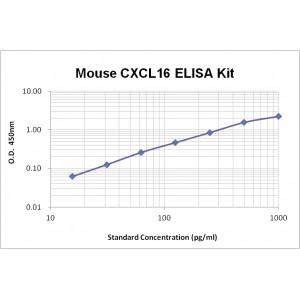More info
Assay Range | 15.6-1,000 pg/mL |
Sensitivity | 1.0 pg/mL |
Size | 96T |
Storage | Store at 2 - 8ºC. Keep reconstituted standard and detection Ab at -20 ºC |
Assay Principle | Sandwich ELISA |
Sample Volume | 100 µL final volume, dilution factor varies on samples |
Detection Method | Chromogenic |
Kit Components
1. Recombinant Mouse CXCL16 standard: 2 vials
2. One 96-well plate coated with anti-Mouse CXCL16 Ab
3. Sample diluent buffer: 12 mL - 1
4. Detection antibody: 130 µL, dilution 1:100
5. Streptavidin-HRP: 130 µL, dilution 1:100
6. Antibody diluent buffer: 12 mL x1
7. Streptavidin-HRP diluent buffer: 12 mL x1
8. TMB developing agent: 10 mL x1
9. Stop solution: 10 mL x1
10. Washing solution (20x): 25 mL x1
Background
CXCL16 (C-X-C motif chemokine 16), also known as scavenger receptor for phosphatidylserine and oxidized low density lipoprotein (SR-PSOX), or small-inducible cytokine B16, is a small cytokine belonging to the CXC chemokine family. Mouse CXCL16 is synthesized as a 246 amino acid (aa) precursor protein with a putative 26 aa residue signal peptide, an 88 aa residue chemokine domain, an 87 aa residue mucin-like spacer region, a 22 aa residue transmembrane domain, and a 23 aa residue cytoplasmic tail. CXCL16 and Fractalkine (CX3CL1) constitute the only transmembrane chemokines identified so far, although a functional soluble form of CXCL16 may occur. Mouse CXCL16 shares 49% aa sequence identity with human CXCL16.
In humans, CXCL16 is expressed primarily on the surface of antigen presenting cells (APCs) including CD19+ B cells, monocytes/macrophages, and dendritic cells, it may also be expressed by some T cells, smooth muscle cells, and endothelial cells. Mouse CXCL16 is produced by dendritic cells in lymphoid organ T cell zones and by cells in the splenic red pulp both as membrane-bound and soluble forms. The chemokine receptor CXCR6, a co-receptor for HIV entry, is a receptor for CXCL16. CXCR6 is expressed on naive CD8+ T cells, Th1 polarized CD8+ and CD4+ T cells, NK T cells, plasma cells, and astrocytes. CXCL16 can stimulate CXCR6-dependent chemotaxis, and this activity is pertussis toxin-sensitive in T cells. In plasma cells, CXCL16 can stimulate chemotactic migration and enhance adhesion to fibronectin. It is shown that CXCL16 acts as a scavenger receptor, mediating the uptake of phosphatidylserine and oxidized low density lipoprotein (Ox-LDL), and the phagocytosis by APCs of both gram-negative and gram-positive bacteria.


